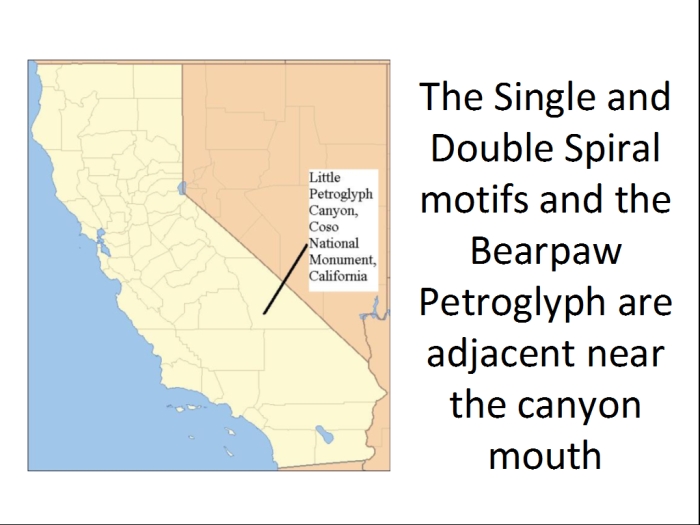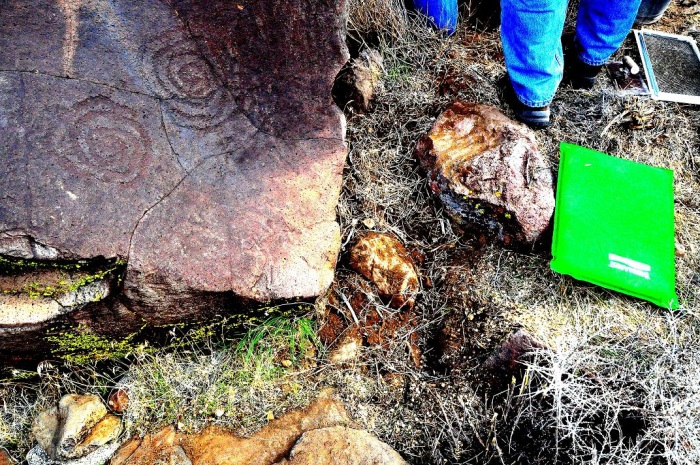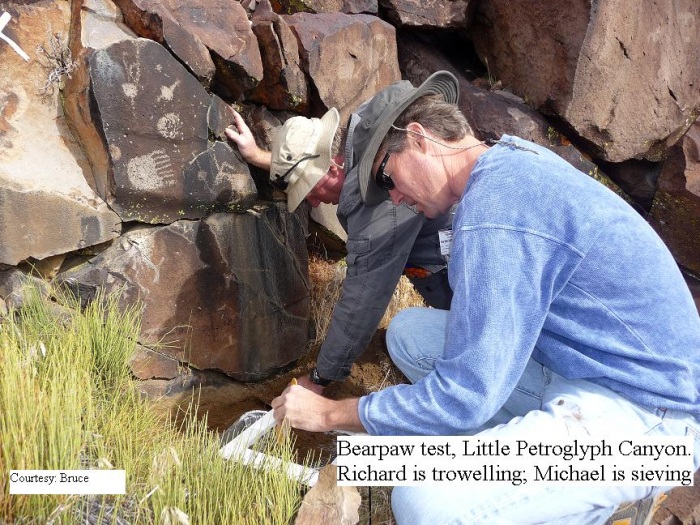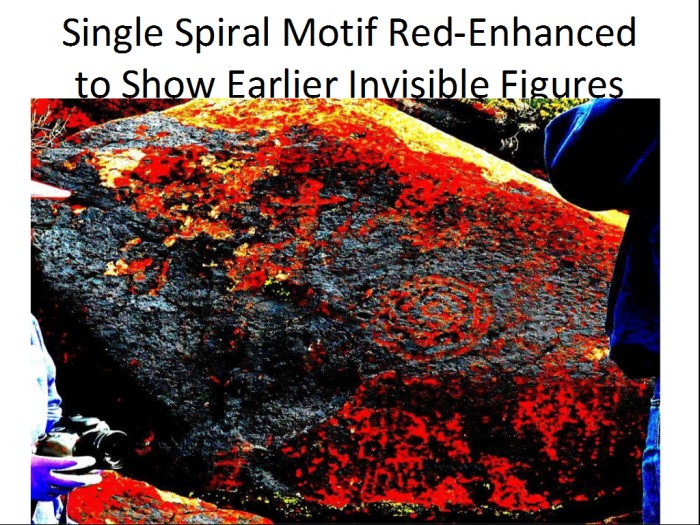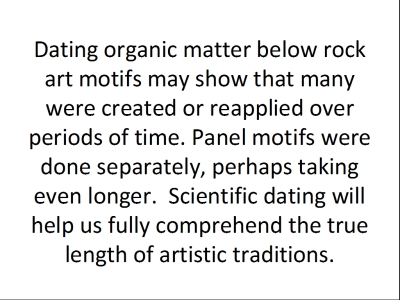Society for American Archaeology, Sacramento, California, March 30—April 3, 2011
By Bryan C. Gordon, Canadian Museum of Civilization
PETROGLYPHS – DATING THE OTHER 95% OF ROCK ART
I changed my title and contents to reflect research done since my abstract. I want to show you how you can date your rock art using simple testing. My pictograph dating is presented elsewhere on this website. You can also Google Gordon Carleton Dating. I will focus here on dating petroglyphs.
My pictograph dating paper at the SAA Atlanta conference was based on fallen dried red ochre droplets and dust. These were on the surfaces of 5 mm scraped levels in a 20 x 25 cm soil test under the art (Slide 1). They were separated from soil grains using the ‘similar’ and ‘inverse’ functions in art software. Pigment particles also appear on wet glue-coated paper applied to each scraped level (Slide 2). Glue sheets remove about a mm of soil, as in these Stein Valley double tests in British Columbia. The remaining 4 mm of soil is filtered through a kitchen sieve. Even a cup of seemingly sterile Mexican desert sand gave a mg or more of carbon-datable material. Other soils may contain enough carbon for a cheaper regular radiocarbon estimate.
At the Atlanta conference I gave my results on Baja California’s Montevideo pictograph. Despite finding fallen pictograph chips, a critic asked proof of particles coming from the art. If natural, they should be in most soil levels, but were not. I adopted glue paper to capture them. (Slide 3) In Stein Valley we linked ochre particles to the art using Scattered Electron Microscopy.
(Slide 4) After dating pictographs in five regions of Canada, the US and Mexico, I chose the West Coast and adjacent Plateau to find Salish art of the same period and culture. I felt this would improve their interpretation and stylistic dating which are subjective. We now have pictograph dates at Lil’Wat near Whistler in British Columbia and the Okanogan in Washington State. Research shows most world art is engraved, so I adapted my method to petroglyphs. As Salish pictographs and petroglyphs are weathering quickly, we enhanced them to show hidden motifs and palimpsests. They suggest different stages of art production occurred, complementing our buried rock art in many levels.
(Slide 5) I knew that pigment rendering as seen here with a camera would not work for dating petroglyphs, but thought soil sifting would separate rock art debris. Attendees at the 2010 IFRAO Conference in France understood my pictograph dating, but said petroglyphs could not be dated that way. I told them my petroglyph dating was not based on pigment but on buried hammerstones or their chips, line grinders and the rock flour they make, as well as fallen chunks of parent rock. We used rough air vent screens to capture larger rock art debris and finer screens like flour sifters and tea strainers for rock flour and tiny hammerstone particles. Filter-clogging clay and silt in some soils was removed by suspending in water, decanting and filtering.
Hammerstones are mainly elongated cobbles of shock-resistant quartz, quartzite or basalt, that are pocked at one or both ends. Petroglyph production is much faster with a hammerstone than a line grinder because shock penetrates rock faster than grinding. Line grinders smooth and align the pockmarks, producing rock flour. Rock flour is whitened from size reduction, even when its parent rock is either dark sandstone or basalt. Very fine, rounded sand grains and flatter rock flour may be separable but need washing for lens differentiation.
Hammerstones rarely occur on the surface because they are used for other tasks. Their chips were given little past attention, but our tests show their size and sharp edges correspond to hammerstone pockmarks (Slide 6). Large chips are caught in the basket; smaller chips in the sieve (Slide 7). Large sandstone chips also fall from the art (Slide 8), while sandstone flour (Slide 9) from the art is caught in the sieve.
(Slide 10) Our first petroglyph tests were on Gabriola Island, opposite Nanaimo on south Vancouver Island. (Slide 11) We began at the famous Thunderbird sandstone petroglyph, choosing a 12 mm soil thickness rather than 5 mm because art tools or their chips may exceed 5 mm. (Slide 12) We found sandstone chunks and sandstone, basalt and quartzite hammerstones or their chips in most levels to 26, with rock flour to 31. Sandstone grinders were in four levels, their flour in 14 levels. (Slide 13) Hammerstones and their chips and line grinders were mainly quartzite, then quartz and basalt.
(Slide 14) Our second petroglyph was the equally famous Sea Wolf motif several km away. (Slide 15) In its 21 levels above large stones and sterile soil we found much more organic and rock art debris than Thunderbird. Quartzite, basalt, conglomerate and sandstone hammerstones or their chips were found in nine levels. (Slide 16) Sandstone and several quartzite line grinders were in six levels and rock flour in eight levels, the bottommost with a grinder. Like Thunderbird, hammerstones and their chips (Slide 17) were mainly quartzite, followed by greywacke, basalt or rhyolite. Sea Wolf and Thunderbird are likely contemporaneous.
(Slide 18) Turning south to central California, we tested three panels in Little Petroglyph Canyon in the China Lake Naval Air Weapons Range. We halved our test size and reverted to our original 5 mm levels because the soil is very shallow and the petroglyphs bore no sign of large chip removal. The Navy shortened my allotted time from four days to six hours. This made it impossible to test sterile sand away from the art, as recommended at the IFRAO conference. (Slide 19) I was able to test the Single & Double Spiral and Bear Paw petroglyphs with three crews of three members each. Boulders were light rhyolite coated with dark desert varnish, making them appear like black basalt. Motifs were made by pocking through the varnish. Hammerstones have never been found but may be massive quartz, based on conjecture in the Mojave Desert. I found an unaltered quartz cobble on the canyon floor and used it to penetrate desert varnish on an unaltered rhyolite cobble. Since the Coso sheep motifs were widely studied, local archaeologist Sandy Rogers asked if I might date the possibly older geometric forms, plus the odd and likely later Bear Paw motif.
(Slide 20) I chose the concave-faced Double Spiral petroglyph boulder because art debris would have funnelled into our test soil. (Slide 21) I also wanted motifs where flying hammerstone chips would have been deflected back into the soil below the art. Soil below the Double Spiral motif was tested down 12 levels to 6 cm. Possible sharp quartz hammerstone chips were in four levels, with rhyolite chips in two levels that had fallen naturally from its boulder. Carbon samples were in all levels, as was rock flour.
(Slide 22) The Single Spiral motif was completely enclosed by high boulders. Soil below the Single Spiral motif contained 21 levels to a depth of 10.5 cm. Sharp quartz chips, possibly from hammerstones, were only in levels 6 and 7, but quartz chips in levels 12 may have originated likewise. Naturally fallen rhyolite chunks were in most levels, as were carbon samples. Rhyolite flour was absent because line grinders were not used. (Slide 23) As motif visibility differs with sun angle, we enhanced the Double & Single Spiral motifs using software, revealing older motifs. These findings correspond to our multi-levelled art debris in showing older art applications.
(Slide 24) I chose the Bear Paw petroglyph because its main motif was surrounded by dart throwers pre-dating the 800 AD bow and arrow. A deflecting boulder and its sloping rock face would have directed art debris to the soil where we tested. The Bear Paw motif had 10 levels to a depth of 5 cm. Possible quartz hammerstone chips were found only in levels 5 and 7. Rock flour was in most levels, with quartz crystals from hammerstones absent. Carbon samples were in all levels except 7, with much organic material in four levels.
(Slide 25) In conclusion, all five petroglyphs tested at Gabriola and Coso were likely made in stages. Gabriola’s deeply ground motifs were repeatedly visited over the last 1000 years. Coso’s shallow pocked motifs barely penetrated the desert varnish, yet were likely done in stages, especially complex panels. Hammerstones were used, with little sign of line grinders. The motifs enhanced on the same panel as the Single Spiral motif were likely done much earlier. The slightly and evenly weathered Bear Paw panel with its dart throwers was likely jointly done more than 1000 years ago. Dating several soil levels under a panel will help us comprehend the true length of art traditions.
Acknowledgements:
Mary Wohlleben, Eva Linklater, Midge Gordon and Robbie Robinson assisted in testing the Gabriola petroglyphs. Both pairs of landowners Glenna Borsuk & Don Gatley and Dave & Keni Lorette provided access to the art, and Don and Mary covered three petroglyph boulders a week before our arrival to keep their soil dry for sieving. Duaine and Vieno Lindstrom, Michael and Richard Heath, Pete McQueen and Bruce Thompson tested the Single Spiral and Bear Paw tests. Kish LaPierre and Sandy Rogers were helpful in guiding us to Little Petroglyph Canyon and assisting in testing the Double Spiral motif with Midge Gordon. At the Museum, Don Gribble, Alicia Ghadban and Frank Bayerl separated samples using sieving, flotation and microscopy. Frank and Alicia proofread this paper. Archaeological permits were issued through the Archaeology Branch of the British Columbia Ministry of Tourism, Culture and the Arts, and the United States Navy.

















